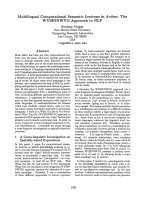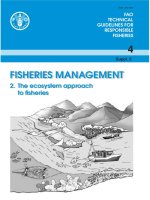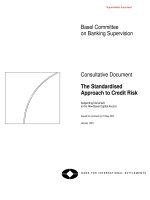The Realise approach to Online advertising
Bạn đang xem bản rút gọn của tài liệu. Xem và tải ngay bản đầy đủ của tài liệu tại đây (3.18 MB, 34 trang )
right brain left brain harmony
The Realise approach to
Online advertising
Offline’s ugly cousin
Losing the popularity contest
Consumers do not trust advertising.
Messages attributed to a commercial source have much lower credibility and much lower impact on the
perception of product quality than the same message attributed to a rating service. Forrester Research has
completed studies that show that advertising and company sponsored blogs are the least-trusted source of
information on products and ser vices, while recommendations from friends and online reviews from customers
are the highest.
Consumers do not want to view advertising.
Think of watching network TV news and remember that the commercials on all the major networks are as closely
synchronized as possible. Why? If network executives believed we all wanted to see the ads they would be
staggered, so that users could channel surf to view the ads; ads are synchronized so that users cannot chan-
nel surf to avoid the ads.
Consumers do not need advertising.
My own research suggests that consumers behave as if they get much of their information about product offer-
ings from the internet, through independent professional rating sites like dpreview.com or community content
rating services like Ratebeer.com or TripAdvisor
Eric Clemons, NY Times, March 09.
Advertising blindness.
Audiences have learned how to filter out the intrusive (Nielson eyetracking research).
They’re not just avoiding advertising, but things that resemble advertising.
There is hope
It’s not all bad news
You are 5x more likely to convert in a banner than convert on a site as a
result of clicking on a standard banner.
The inclusion of an incentive, such as a giveaway or access to exclusive
content, will positively impact the data capture rates.
Consumers are nearly 8x more likely to fill in a form in a banner then click on it .
34% of unique users who interact will fill in form details within a banner.
Popular rich media formats are showing 2.5x uplift in the ability to generate
conversions over standard display inventory.
One can measure an increase in search activity as a result of display advertising
that is sustained for a sizeable amount of time. Messages clearly resonate.
Eyeblaster research 09.
It’s early days
There are few experts so quality is low.
Many advertisers making schoolboy errors.
History shows that people like great advertising.
So how can be more impactful?
Turn heads
Be attractive and pleasing to the eye.
Without being gratuitous or sensationalist.
The viewer should want to look not have to look.
Be interactive
Give viewers a reason to get involved.
Make the interaction rewarding and enjoyable.
Capture data and start a relationship.
Innovate with software
Think about the way the message is created and presented.
Use software to create depth, dimension and movement.
Create an interface that is intuitive, dynamic and usable.
ypography is alive
Although many online designers are trying to kill it.
Use great fonts. Use space wisely. Kerning, Leading, tracking, alignment.
Treat your space as if you were printing it.
Picture perfect
Anyone can use a stockshot.
Few people notice them.
Photography can add gravity, provenance
and impact to your message.
Use images that captivate the eye.
Open spaces
Just because you’ve paid for 468*60 pixels
doesn’t mean you have to utilise every single one.
A message requires breathing space.
The eye likes to see a frame.
Jurassic Park
There’s only so much you can achieve on a camcorder.
Keep production values as high as budget allows.
If the video looks cheap it cheapens the brand.
Be iconic
Develop a strong visual style.
Be instantly recognisable.
But evolve over time.
Lightness of touch
It’s not just about bold colours, bold fonts,
bold images and bold statements.
Simplicity can be just as powerful.
Quick to respond
Production and upload times mean you can react in
real time and make your messages topical.
Adding greater relevance and improved response.
Watch and learn
Respond to the analytical results of your work.
Look at the way the audience interact and ask questions.
Read between the lines and you can improve efficiency,
Remove barriers
Look at the reasons people wouldn’t buy from you.
Find ways to turn those inhibitors into benefits.
Challenge their views and contradict perceptions.
Strange shapes are interesting
Banners are very angular and often the content reflects that.
Rollovers don’t have to roll out at right angles.
Page overlays don’t have to be page shaped.
Entertain
It’s still the best way to be liked.
Get a move on
No one has time to wait for you’re point to be made.
The audience is busy, you’re a distraction, so be quick.
2 seconds is good, 3 second is OK, 4 seconds is eternity.
Don’t squeeze too much in
The Full page press ad won’t squeeze into a banner.
Create executions specifically for online.
It’s a good discipline to do your online first.









